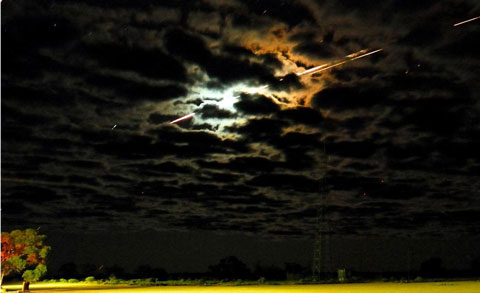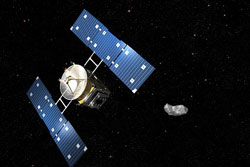There and Back Again: An Asteroid's Tale
Asteroid collisions with Earth often make for great Hollywood plots, but real asteroids have zipped unnervingly close to us in recent years. NASA and other space agencies have active programs to study, track and prepare for asteroid strikes.
Scientists obviously want to prevent a catastrophic collision, but these 4.5 billion year old space rocks also contain valuable information about the history of the solar system and the origins of life. They may even be mining sites for platinum or other precious metals someday.

The Japanese Hayabusa spacecraft streaks across the sky before delivering asteroid samples back to Earth. Image Credit: NASA/Ed Schilling
Most of our asteroid knowledge stems from Earth-based observations, spacecraft flybys over the past 15 years, and meteorite studies. Recently, however, scientists have brought outer space into the lab. For the first time, they are now analyzing grains of microscopic dust brought back from the surface of an asteroid.
Collecting Asteroid Dust
The Japan Aerospace Exploration Agency’s Hayabusa mission collected the samples from an asteroid called 25143 Itokawa. Hayabusa was plagued by delays and problems, but the mission ultimately succeeded in returning more than 1,500 grains of the historic dust. The mission to study Itokawa and bring back samples spanned nearly seven years from the craft's 2003 launch to its 2010 landing in the Australian desert.
Discovered in 1998, Itokawa is a stony asteroid about 630 meters long and 250 meters wide. It was named after Hideo Itokawa , a pioneering Japanese rocket scientist. This asteroid was chosen as Hayabusa's destination because of its location relative to the Earth and its exploration value.

An artist's rendition of Hayabusa's approach to the Itokawa asteroid.
Image Credit: Akihiro Ikeshita/JAXA
Itokawa is an S-type asteroid (the S stands for silicaceous, which means rich in silicon). This is the second most common type of asteroid. The most common is the C-type. The C stands for carbonaceous, which means rich in carbon. About 75% of all asteroids are C-type; 17% are S-type; and most of the remaining 8% are M-type, or metallic-type.
The brief video below illustrates Hayabusa's journey. First you see the spacecraft travel to the asteroid, a trip that took about two years. Hayabusa then observes the asteroid from a distance before releasing a hopping mini-lander to take data on the temperature and surface variability. Next, the spacecraft touches down on the surface twice, the second time kicking up dust and collecting samples. After a brief stay on the asteroid, Hayabusa heads back to Earth and releases a re-entry capsule that brings the samples safely through the Earth’s atmosphere to a landing place in the Australian desert.
Hayabusa was a great technological challenge. Not everything went as planned — for example, the hopping mini-lander was released too far from the surface of the asteroid and never made it there. Despite this and other setbacks, the re-entry capsule made it back with the treasured samples.
After the dust came back to earth, scientists first verified that the samples were authentic and not just Earth dust that snuck into the capsule. With verification complete, the scientists developed procedures for handling the unique samples to prevent contamination. In early 2012, JAXA was ready to start releasing the asteroid dust to a wider audience. The agency sought proposals from external scientists interested in studying the samples and began distributing the dust to research laboratories around the world.
What the Dust Tells Us
While scientists expect to learn much more from these tiny bits of Itokawa, the initial studies have already yielded some interesting results. For example, evidence indicates that the rocks and dust that make up Itokawa were once part of a larger asteroid that broke apart.
After the asteroid broke apart, pieces of its interior likely crashed into one another and stuck together, eventually forming the Itokawa we know today. Tests indicate that the dust now on its surface has been exposed for about eight million years. That seems like a long time, but most asteroids are thought to have formed at the same time as the solar system, about 4.5 billion years ago!

Fragments of Itokawa are now being analyzed in labs across the globe.
Image Credit: University of Manchester
Chemical studies suggest that the particles are very similar to those found in meteorites that crashed on Earth, confirming that meteorites usually come from S-type asteroids like Itokawa. In addition, the chemical composition of the Itokawa dust exactly matches Earth-based spectroscopic measurements of the asteroid. This lends credibility to the technique of using chemical and spectral analysis to match meteorites with their parent asteroids.
As scientists around the world begin scrutinizing the dust particles in hopes that they will unlock some of the mysteries surrounding the formation of the solar system, JAXA is gearing up for a proposed Hayabusa-2 mission. This new and improved version of the Hayabusa mission would blast off in 2014 for a C-type asteroid. Just a few tiny samples of a C-type asteroid could contain volumes of information about the origins of life on Earth. Stay tuned!
More Information and Resources
- NASA: Solar System Exploration Asteroids Overview
Explore asteroids from every angle using this resource, which includes links to asteroid videos, images, and missions, profiles of scientists working on asteroid research, asteroid news stories, and more.
- NASA Jet Propulsion Laboratory (JPL): Asteroid Watch
Keep track of breaking news, videos and more on the asteroids, meteors, comets and other near earth objects discovered, tracked and analyzed by JPL spacecraft.
- JAXA: Asteroid Exploration Hayabusa
Explore the Hayabusa mission in more detail on the Japan Aerospace Exploration Agency's project site.
- Hayabusa-2 Project
Learn more about the proposed Hayabusa-2 mission and the new technologies that will be incorporated into the mission.
- Physics Buzz Blog: Asteroid Hurtles Past Earth Tonight
Read about a 2011 asteroid that flew 201,700 miles (321,867 km) above Earth's surface at its closest approach.
—Kendra Redmond














